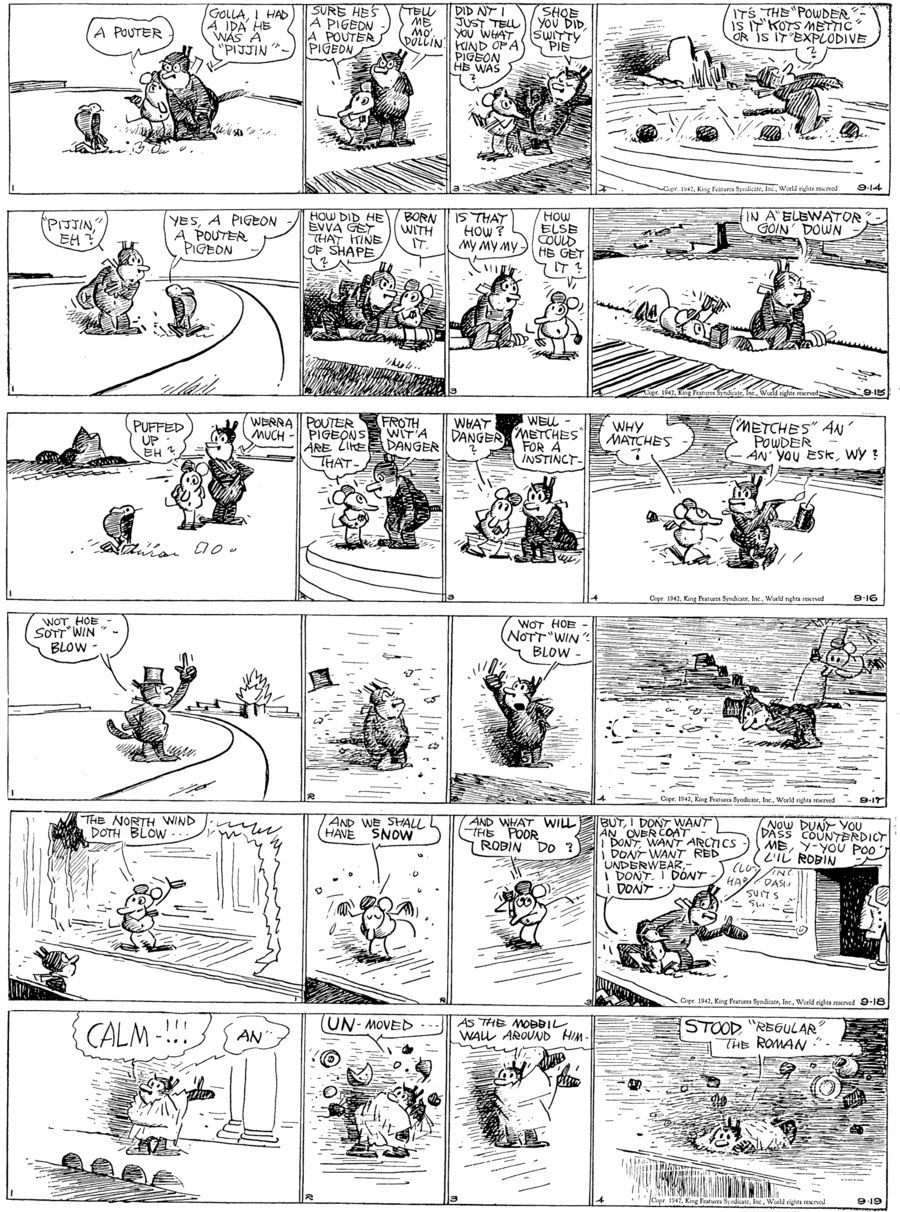 Â Your Comics Page begins with Krazy from 9-14 to 9-19-1942 this time. You’ll note that the first three dailies are about Pouter pigeons, which Krazy thinks are “Powder” pigeons and might explode (wartime flavored gag). The next two dailies address the old poem “The North Wind Doth Blow” or “The Robin”. No one remembers who wrote the old English Nursery Rhyme, which no doubt dates back hundreds of years. My mother used to recite it to me, and I memorized it. But what is the poem Krazy is reciting in the 9-19? Is it from “Julius Caesar” by Shakespeare, or “The Martyr of the Catacombs”? If anyone can solve this Kat puzzler, a lifetime subscription to this blog is your reward!
 Your Comics Page begins with Krazy from 9-14 to 9-19-1942 this time. You’ll note that the first three dailies are about Pouter pigeons, which Krazy thinks are “Powder” pigeons and might explode (wartime flavored gag). The next two dailies address the old poem “The North Wind Doth Blow” or “The Robin”. No one remembers who wrote the old English Nursery Rhyme, which no doubt dates back hundreds of years. My mother used to recite it to me, and I memorized it. But what is the poem Krazy is reciting in the 9-19? Is it from “Julius Caesar” by Shakespeare, or “The Martyr of the Catacombs”? If anyone can solve this Kat puzzler, a lifetime subscription to this blog is your reward!
My esteemed brother and retired Calculus tutor, Kurt, says: “The quote in the Krazy strip is from ‘Supposed Recitation of Regulus’, a popular ‘recitation’ piece of the period by Elijah Kellogg. You can find it complete if you google it. The actual quote is ‘Calm and unmoved as the marble walls around him, stood Regulus, the Roman!’ Pretty gripping stuff, huh?”
Not only gripping, but winning! Thanks Oh Mighty Tutor, you now have a lifetime subscription to the Catblog!
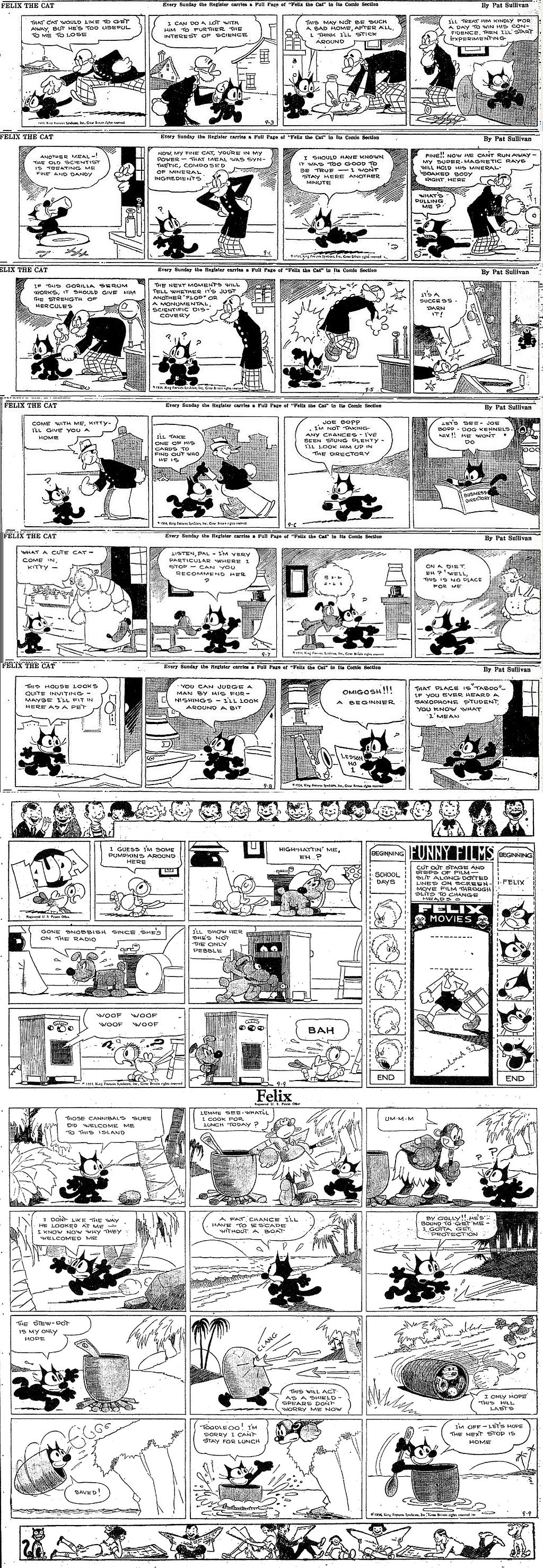 Â Felix is from 9-3 to 9-9-1934 this time. He escapes from the evil scientist by punching him out after receiving an injection of Gorilla serum. Felix is less trusting of future homes, as he rejects a maker of dog kennels, a fat lady on a diet and a beginning saxophone player. In the Sunday 9-9 episode, Felix does a quick escape from the cannibal island by turning the shell casing into a sort of canoe. We’ll see if he gets home from there next time.
 Felix is from 9-3 to 9-9-1934 this time. He escapes from the evil scientist by punching him out after receiving an injection of Gorilla serum. Felix is less trusting of future homes, as he rejects a maker of dog kennels, a fat lady on a diet and a beginning saxophone player. In the Sunday 9-9 episode, Felix does a quick escape from the cannibal island by turning the shell casing into a sort of canoe. We’ll see if he gets home from there next time.
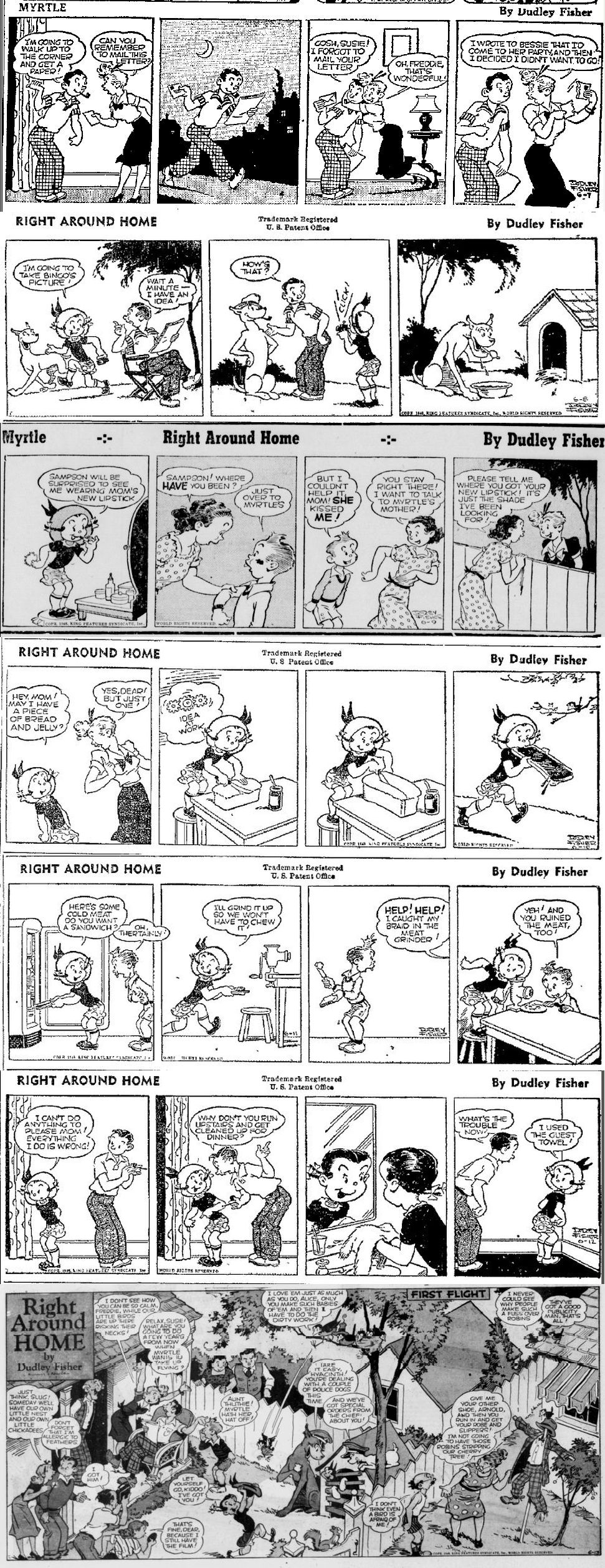 Â Dudley Fisher’s Myrtle is from 6-7 to 6-13-1948 for this post. My favorite daily is the 6-8. Myrtle takes a gag photo of Bingo dressed up in Freddie’s hat and pipe, resulting in Bingo eating his meals with a spoon! Fisher lets the reader fill in the gaps here, as Bingo makes the leap up the anthropomorphic ladder from wearing hats and smoking pipes to eating his meals with a human utensil. I also love the 6-10, as Myrtle asks for a piece of bread and jelly and restricted to “just one” by Susie, Myrtle slices the bread length ways (you got your bread unsliced in 1948) and chows down on a cinemascope slice. The Sunday, 6-13 is called “First Flight”. Hyacinth the cat is fastened securely in Bingo’s doghouse as a baby robin takes it’s first test hop out of the nest into Myrtle’s hat.
 Dudley Fisher’s Myrtle is from 6-7 to 6-13-1948 for this post. My favorite daily is the 6-8. Myrtle takes a gag photo of Bingo dressed up in Freddie’s hat and pipe, resulting in Bingo eating his meals with a spoon! Fisher lets the reader fill in the gaps here, as Bingo makes the leap up the anthropomorphic ladder from wearing hats and smoking pipes to eating his meals with a human utensil. I also love the 6-10, as Myrtle asks for a piece of bread and jelly and restricted to “just one” by Susie, Myrtle slices the bread length ways (you got your bread unsliced in 1948) and chows down on a cinemascope slice. The Sunday, 6-13 is called “First Flight”. Hyacinth the cat is fastened securely in Bingo’s doghouse as a baby robin takes it’s first test hop out of the nest into Myrtle’s hat.
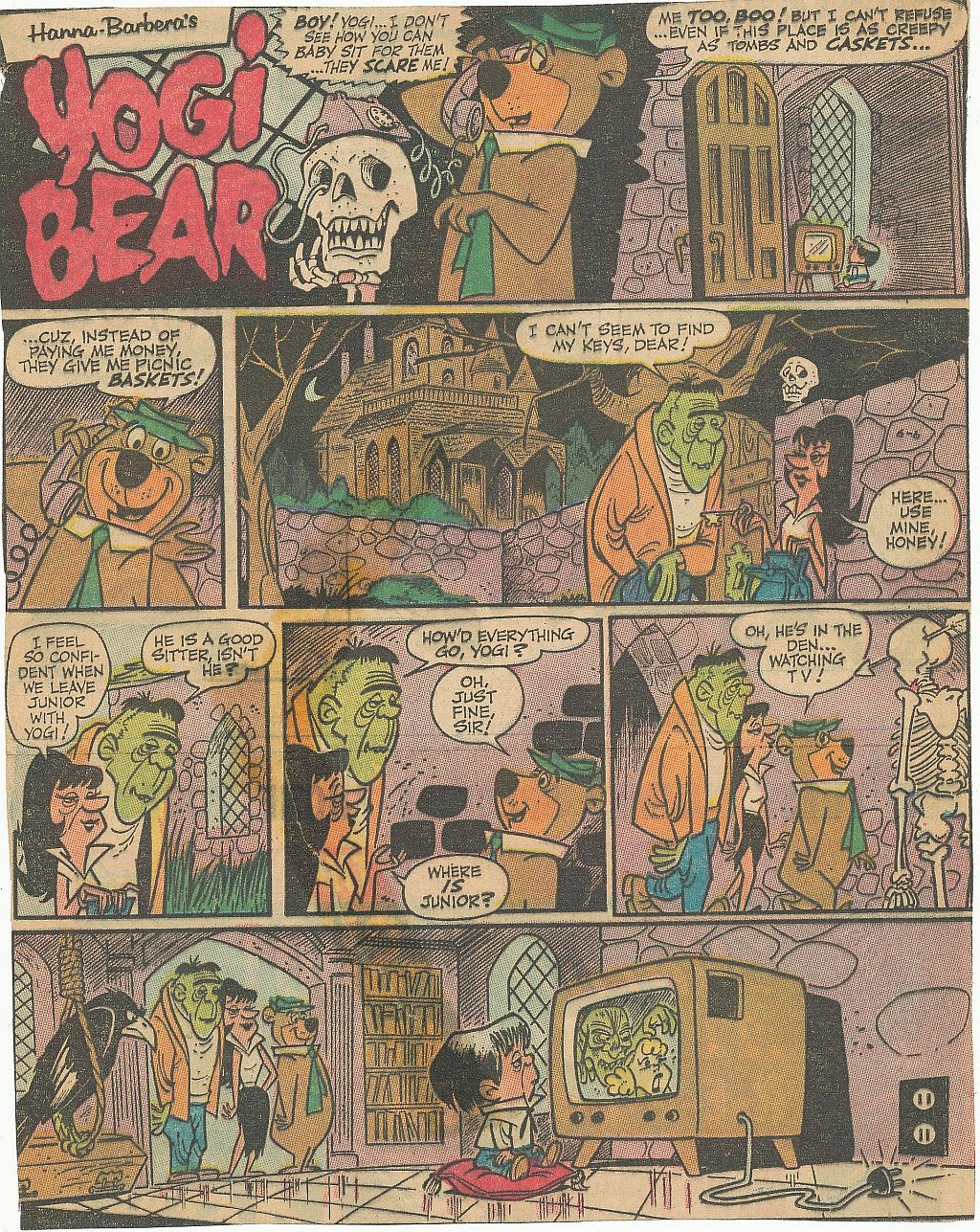
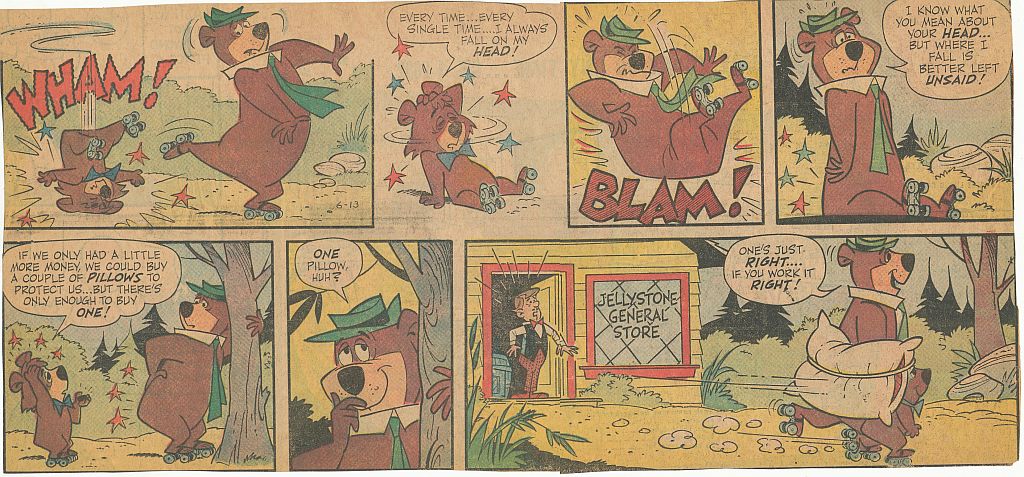
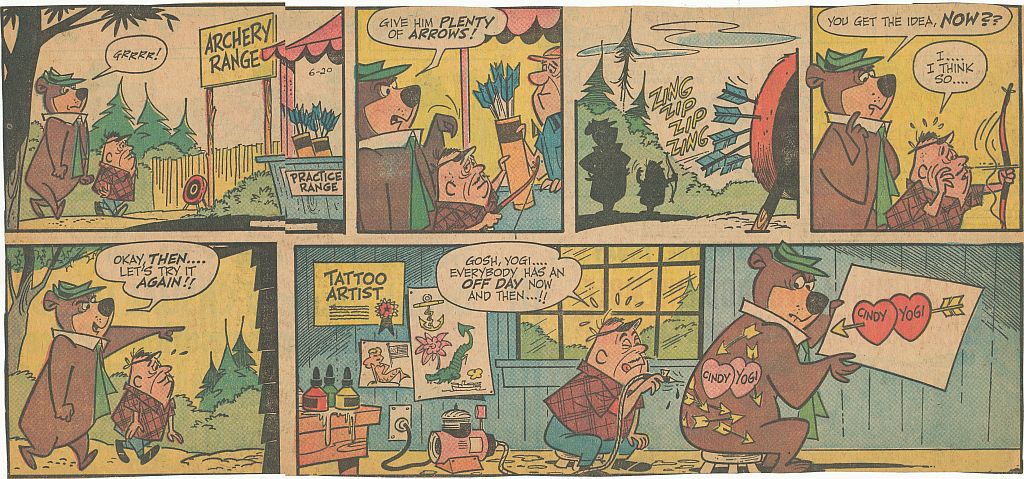
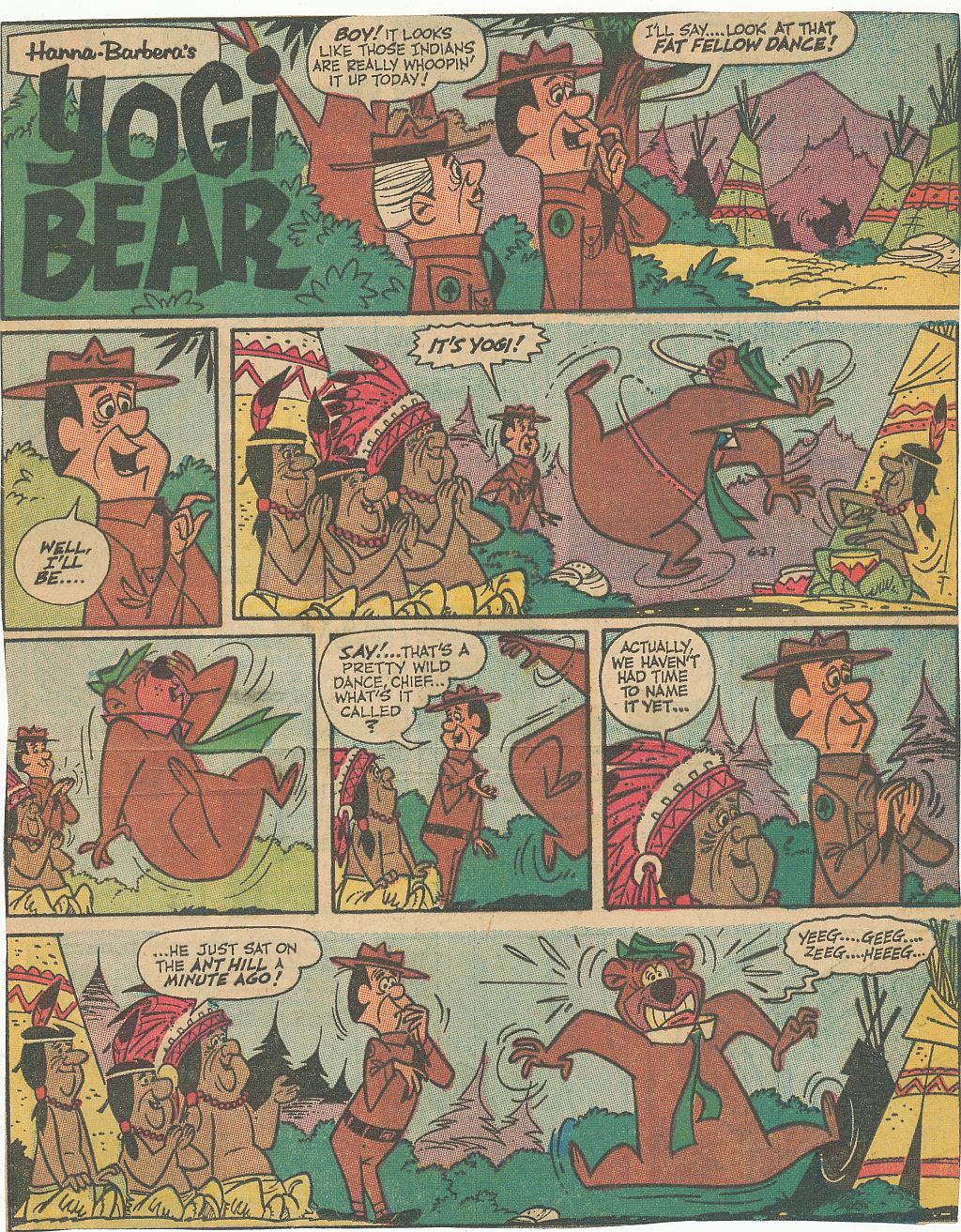 Â The Yogi Bear Sundays from June, 1965 are here, courtesy of the St. Louis Post-Dispatch. Harvey Eisenberg’s legacy continues for now, but in the July episodes other hands start carrying the load. The 6-6 episode is a beautiful drawing job, as Yogi baby sits for a Charles Addams type couple who seem to be the missing links between Mr. and Mrs. J. Evil Scientist and The Gruesomes. The 6-13 is OK, but the last panel seems to drop the ball a little as Yogi and Boo-Boo skate away from the Jellystone General Store with a pillow somewhat awkwardly placed near their rear ends! Yogi’s rhyme is rather lazy here too, he matches “right” with “right”! The 6-20 has some good Eisenberg staging in it as Yogi tries to get a tattoo artist to draw an arrow correctly. The concept is a bit weak here, Yogi doesn’t have human skin, so a tattoo on his fur would disappear almost immediately. The 6-27, once again drawn by Eisenberg, seems to reprise an earlier Indian gag, as Yogi seems to be doing a tribal dance, when actually the gyrations are caused by sitting on an ant hill. I’m sure that Yowp will come up with more complete copies of these Sundays in his blog soon, so keep checking in at www.yowpyowp.blogspot.com .
 The Yogi Bear Sundays from June, 1965 are here, courtesy of the St. Louis Post-Dispatch. Harvey Eisenberg’s legacy continues for now, but in the July episodes other hands start carrying the load. The 6-6 episode is a beautiful drawing job, as Yogi baby sits for a Charles Addams type couple who seem to be the missing links between Mr. and Mrs. J. Evil Scientist and The Gruesomes. The 6-13 is OK, but the last panel seems to drop the ball a little as Yogi and Boo-Boo skate away from the Jellystone General Store with a pillow somewhat awkwardly placed near their rear ends! Yogi’s rhyme is rather lazy here too, he matches “right” with “right”! The 6-20 has some good Eisenberg staging in it as Yogi tries to get a tattoo artist to draw an arrow correctly. The concept is a bit weak here, Yogi doesn’t have human skin, so a tattoo on his fur would disappear almost immediately. The 6-27, once again drawn by Eisenberg, seems to reprise an earlier Indian gag, as Yogi seems to be doing a tribal dance, when actually the gyrations are caused by sitting on an ant hill. I’m sure that Yowp will come up with more complete copies of these Sundays in his blog soon, so keep checking in at www.yowpyowp.blogspot.com .
 Â I just finished (after 5 months) watching this historic DVD set of Red Skelton shows published by The Shout Factory. Here is my review:
 I just finished (after 5 months) watching this historic DVD set of Red Skelton shows published by The Shout Factory. Here is my review:
Red Skelton Show, The Early Years Shout Factory 11 Disc Set
The name “Red Skelton” is fading away in the 21stCentury, but way back in the 20th, he was a beloved and well-known comedian. In our family home when my brother and I were little, Red “visited” us by TV nearly every week. Our Grandma Katie just adored Red, although she seldom laughed at his actual comedy. She loved his shy little four-fingered wave to the audience as he came on to the stage, the dimples in his smile, and his show-closing phrase: “Good night and may God bless!” This is the Red Skelton that is best remembered today, the “old people’s” Skelton.
The Skelton in this 11 disc DVD set released by The Shout Factory, is not for the most part, the “old folks” Skelton. The earliest TV shows Red did are visual extensions of his radio program. Red’s radio programs from the 1940 to 1944 and the 1945 to 1954 seasons were his true legacy. Like Joe Penner before him, Red had the capacity to be both inside and outside of his material at the same time. His most endearing character from his radio days was the “Mean Widdle Kid”. “Junior” was wise beyond his years, one of the craftiest rascals on radio. He played off Harriet Hilliard as his mother on the early shows, but the funniest Junior scripts featured Verna Felton as his “Namma”. She often spoke to Junior with that “Hairbrush tone” in her voice. There were no “time outs” in Junior’s lexicon, just extreme corporal punishment. Junior made “I dood it” and “He don’t know me very well, do he”, beloved catch phrases, but Red’s outstanding achievement with the character was making such a brat seem somehow endearing. Junior’s influence on cartoons of the 1940s and 1950s was in every Wise Guy hero, from Bugs Bunny to Tweety, Woody Woodpecker, Skrewy Squirrel: every character that broke the 4thwall and had no respect for authority owed their existence to Red Skelton’s radio program and his head writer and first wife, Edna Stillwell. Skelton’s other radio characters, such as Clem Kadiddlehopper were imitated by Tex Avery (“The Hick Chick”) and by Bill Scott as Bullwinkle Moose, “Deadeye”’s “Aw, Come On Horse, WHOA!” became components of Yosemite Sam and Quick Draw McGraw–Mike Maltese, who wrote for these characters, was imbued with Red’s comic bad guys.
The first Skelton TV shows tried to do a visual version of the radio program. Ironically, although Red looked hilarious as Clem Kadiddlehopper with his crossed eyes and receding chin, and Cauliflower McPugg with his broken down prizefighter’s facial ticks and catch phrases such as “a flock of ‘em flew over that time”, or “Deadeye”’s crummy mustache and even crummier marksmanship–all these characters were just as vivid on the radio without the makeup. The listener could easily imagine what they looked like and the attempts by the makeup men to make them visible comes off a little cheesy. It’s significant that Red made almost no attempt to recreate “Junior” visually for TV. He used the “Junior” voice and turned his fedora upside down to simulate being a Fauntleroy type kid, but turned the character into a parody of his own son, Richard. Red was a big guy over six feet, and he wisely decided against performing as Junior alongside Verna Felton or Lurene Tuttle. “Junior” on the radio was a tiny, scampering, atomic powered bundle of mischief, so Red’s stature was all wrong for the character.
Having said all that, these TV shows have their own rewarding qualities. Edna Skelton was still the head writer (even though she and Red were divorced) and the characters that she and Red created could coast on their energy. Red loved to make fun and criticize the writing as he performed it, (“now there’s a brilliant line”, “I’m proud o’that, it ain’t written here”). He would often break up on camera as he went along, and sometimes threw off the timing of his supporting cast in doing so. An early member of that cast, Lucille Knoch, is a standout in these 1950s kinescopes. She’s petite, blonde and very cute, Jeff to Red’s Mutt, and really seems to be enjoying Red’s comedy, mistakes and all. It’s a delight to watch her break up along with Red. Jack Benny was very critical of Red’s unprofessionalism, laughing at himself. Yet somehow breaking up became an integral part of his routine and bridged less-than-perfect comedy writing. Red would comment: “I gotta laugh, ‘cause I know what’s comin’” and “I only just got the joke.”
What’s the value of this SHOUT FACTORY DVD set to a collector of television shows of the 1950s? Invaluable. Red Skelton held the rights to all his television kinescopes, and how fortunate we are that he did hold them and didn’t syndicate the programs. Part of the reason Red didn’t want his early programs seen during his lifetime might have been that his son Richard, who was the subject of many of his father’s comedy routines, died of leukemia before he turned 10, and his second wife Georgia, mother of Red’s two children and featured in several of the Christmas Skelton shows, shot herself to death in 1976. Red was probably too saddened by the loss of Georgia and Richard to look at his old shows. He continued to make new ones until 1971; he preferred to go on and not to look back.
The first season, 1951-52 , has the most manic energy–Red had to change costumes several times in each episode, and there are no “God bless” endings here–Red is usually dragged under the curtain at the end of the show in mid-sentence by a stage hand! Cauliflower McPugg, Clem Kadiddlehopper and Willie Lump-Lump are the featured characters. The show was as big a hit as Red’s radio program and he won two Emmys for his TV program and for being an outstanding comedian. Unfortunately, the first episode from 9/30/1951 is not included in the set, perhaps the print went vinegar–it’s a miracle that so many of these episodes have survived at all, Red must have had good film storage. In the 1952-53 series, they tried to make it easier on Red by filming the performances on a sound stage with mostly canned laughter. The show really suffered without a live audience and Red’s comedy was enhanced by real laughter–so the filmed shows lasted only one season. Being shot on 35mm, they look great.
NBC dropped the Red Skelton show in 1953, due to low ratings, and CBS picked it up, running it on a sustaining basis at first. More shows were one-character per episode affairs and there were many singing/dancing interludes by the “Red-dettes” to give Red some breathing room. It’s a real treat to see these CBS kinescopes. The network had a terrible track record on film storage and most of their early kinescopes were destroyed. We owe Red our gratitude in preserving so much of his television legacy for us to see today.
About this time in the show’s history, a new character began to dominate the programs, a hobo named Freddy the Freeloader. Skelton used his father’s clown makeup for Freddy’s face. In the early appearances Freddy spoke quite a lot, but in the later 1950s and 60s he became largely a pantomime character. He was a gentle soul, but was rather coarse in his manners, I remember an episode that featured Greer Garson, whom Freddy addressed as a “broad”. Red’s skill at acting and comedy without using words make him worthy of study by animators and actors today. He had absolute control over his face and body and could become an old man, a little boy, a drunkard, a haughty dowager or two seagulls just by changing his posture or wearing his hat differently.
There are many Skelton legends that aren’t included in the biography documentary on the bonus disc. Tales such as Red in his dotage responding to unexpected visitors ringing the bell at his Bel-Aire home by running out on to the driveway clad only in a bathrobe and brandishing a rifle! Red supposedly wouldn’t let anyone near the vault rooms in his mansion where all the film was stored, reportedly he refused to show the old kinescopes to people, including himself. Red was a right-wing God and Country type guy in his later years and accused CBS of persecuting him for his politics when they cancelled his show in 1970, still at the top of the ratings.
Shout Factory has cut nearly all the commercials out of Red’s prints but have left the filmed spots he did for Tide Detergent in the first season shows. The ads are funny and painless, nearly devoid of plugs until the last minute of the skit. You won’t find any of the Pet Milk or Johnson’s Wax ads in the later shows, however. Maybe they couldn’t clear the rights.
I give this set the highest rating a film collector can give it–4 Reels! There are so many interesting episodes including guests like Bela Lugosi, Peter Lorre and Vampira and a filmed rehearsal for a 1953 NBC episode featuring “Deadeye From Mars” which lets us in on Red’s freewheeling and irreverent attitude towards his comedy. He cracked up when the elaborate space bicycle prop fails to take off at the end of the sketch. It’s always fun to watch Red just take flubs and fluffs in his stride and make them “funnier than what’s written here”.
By all means get this set and savor it slowly, there are 92 shows included and you’ll be sorry when you’ve used up all the episodes!
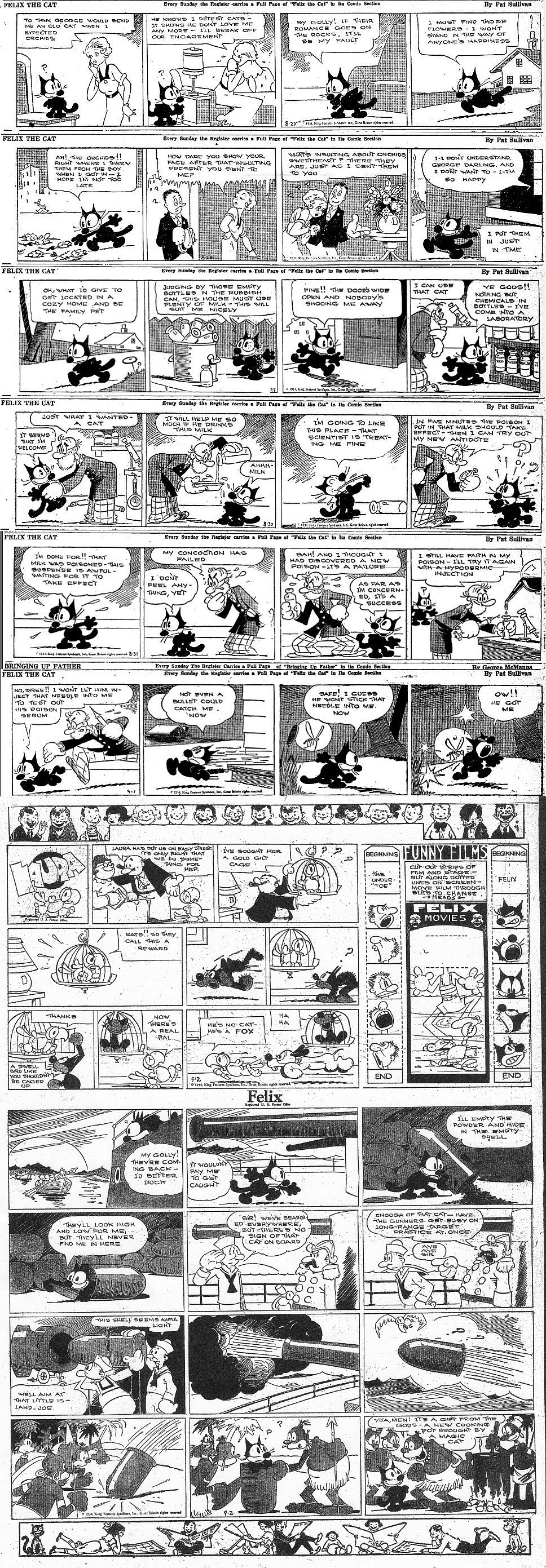 Â Felix is from 8-27 to 9-2-1934 this time. In the dailies, Felix wins over the young lady (who mistakenly believes Felix is a present from her fiancee) with orchids he found lying in the street. Felix searches for a new home, and manages to land one with (who else) a professor who wants to turn the hapless cat into an experimental animal. In the Sunday, Felix hides in an artillery shell to escape the returning crew, only to be fired into space and land on a cannibal island. The cannibals think that the empty shell is a new-fangled cooking pot. I think Messmer used this gag several times. By the way, look at the cat in the “Laura” topper, I have a weak spot for Messmer’s alternate designs for cartoon cats and this is one of his best.
 Felix is from 8-27 to 9-2-1934 this time. In the dailies, Felix wins over the young lady (who mistakenly believes Felix is a present from her fiancee) with orchids he found lying in the street. Felix searches for a new home, and manages to land one with (who else) a professor who wants to turn the hapless cat into an experimental animal. In the Sunday, Felix hides in an artillery shell to escape the returning crew, only to be fired into space and land on a cannibal island. The cannibals think that the empty shell is a new-fangled cooking pot. I think Messmer used this gag several times. By the way, look at the cat in the “Laura” topper, I have a weak spot for Messmer’s alternate designs for cartoon cats and this is one of his best.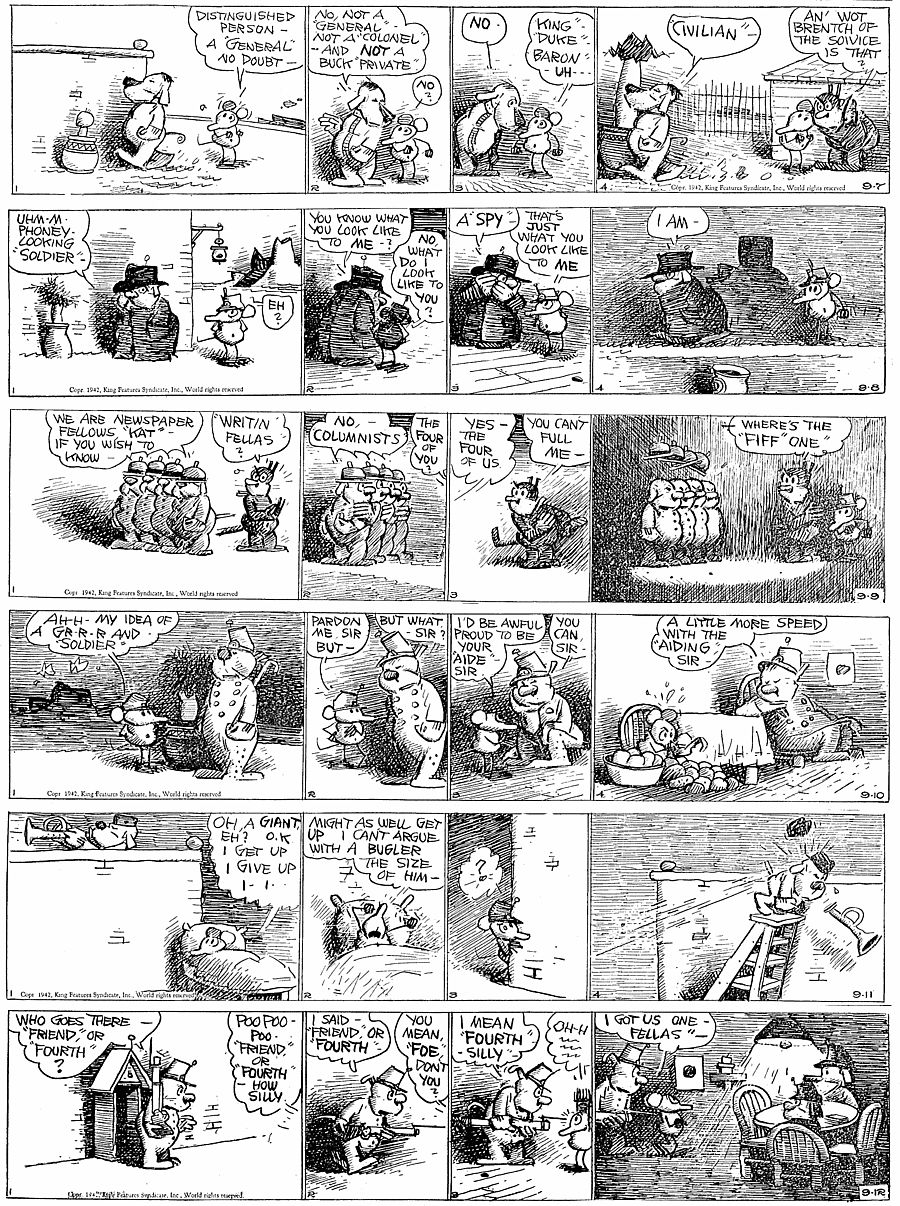  Krazy is from 9-7 to 9-12-1942 this time and Garge’s inking is beautiful! The military gags go through all six strips and feature Ignatz as a private interacting with a lot of army dogs who closely resemble Offissa Pupp. I like the 9-8, in which Ignatz meets a canine spy: great inking in the second, third and fourth panels as the big spy tells Ignatz, “I AM”. The 9-9 is the runner-up for me, as four Ernie Pyle Pupps show up and tell Ignatz they are columnists. Noting that there are four of the dogs, Krazy asks “Where’s the Fiff one?” The “Fifth Column” refers not to journalism, but to military spies, such as Quisling in Poland in 1940.
 Krazy is from 9-7 to 9-12-1942 this time and Garge’s inking is beautiful! The military gags go through all six strips and feature Ignatz as a private interacting with a lot of army dogs who closely resemble Offissa Pupp. I like the 9-8, in which Ignatz meets a canine spy: great inking in the second, third and fourth panels as the big spy tells Ignatz, “I AM”. The 9-9 is the runner-up for me, as four Ernie Pyle Pupps show up and tell Ignatz they are columnists. Noting that there are four of the dogs, Krazy asks “Where’s the Fiff one?” The “Fifth Column” refers not to journalism, but to military spies, such as Quisling in Poland in 1940.![]()  Myrtle is from 5-31 to 6-6-1948, I love the 5-5 as Bingo gives Sampson a nudge which turns on Sampson’s libido. He grabs Myrtle and kisses her, leaving her puzzled. I’ve included the Sunday page which bestows a new power lawn mower on Myrtle. The new gasoline engine mower goes AWOL and smashes through a nearby neighbor’s yard.
 Myrtle is from 5-31 to 6-6-1948, I love the 5-5 as Bingo gives Sampson a nudge which turns on Sampson’s libido. He grabs Myrtle and kisses her, leaving her puzzled. I’ve included the Sunday page which bestows a new power lawn mower on Myrtle. The new gasoline engine mower goes AWOL and smashes through a nearby neighbor’s yard.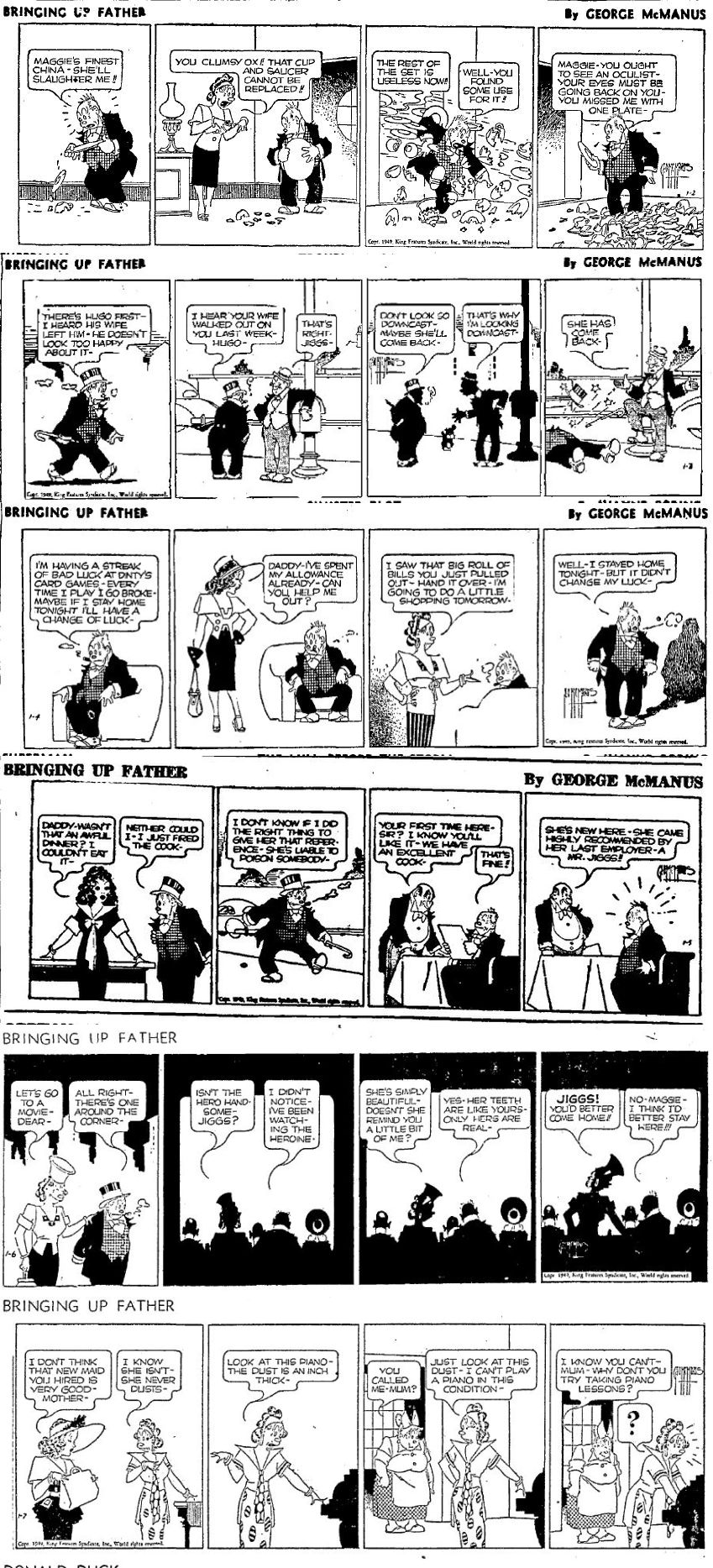  Here is a new feature on the Catblog, George McManus’s BRINGING UP FATHER, from 1-2 to 1-7-1950. The reason Jiggs pops up here? I’m PO’d at the King Features comic website, Comics Kingdom. They have some nice proofs of BUF that they recently stopped running with the episode for 12-31-1949. I think they should have kept running Jiggs in chronological order so the readers could see the eventual abandonment of the dailies by George McManus. If I can run the post-1949 dailies here, why can’t King Features run them on their website? A syndicate that has distributed so many fine features for so many years should have a much more complete archive of their classic strips than they do. By the 1950s, George M. had been cartooning for over 43 years! He passed away in 1954 having logged in 41 years of Jiggs and Maggie, starting in 1913. His ink line was very delicate, and sometimes reminds me of Winsor McCay. McManus drew the whites of his characters’s eyes blank, once in a while with very tiny dots for irises, looking like Harold Grey’s Little Orphan Annie eyeballs. BUF will only be an occasional feature here, as the strips rarely feature continuity, except for the repeating gags of Jiggs being socked by endless crockery from his wife’s well-stocked china cabinets (which he paid for). I always enjoy McManus’s sense of staging, silhouette panels and sense of design. I love the 1-6 as Jiggs and Maggie visit their local movie theatre. McManus suggests the movie show with silhouettes of Jiggs and wife along with other movie goers in front of a totally white space above the line of theater seats. We don’t need to actually see what’s on the screen, the black figures and dialog fill us in on all the movie details. McManus is one of newspaper cartooning’s finest cartoonists, but he is easy to take for granted. Watch for more of his work coming soon.
 Here is a new feature on the Catblog, George McManus’s BRINGING UP FATHER, from 1-2 to 1-7-1950. The reason Jiggs pops up here? I’m PO’d at the King Features comic website, Comics Kingdom. They have some nice proofs of BUF that they recently stopped running with the episode for 12-31-1949. I think they should have kept running Jiggs in chronological order so the readers could see the eventual abandonment of the dailies by George McManus. If I can run the post-1949 dailies here, why can’t King Features run them on their website? A syndicate that has distributed so many fine features for so many years should have a much more complete archive of their classic strips than they do. By the 1950s, George M. had been cartooning for over 43 years! He passed away in 1954 having logged in 41 years of Jiggs and Maggie, starting in 1913. His ink line was very delicate, and sometimes reminds me of Winsor McCay. McManus drew the whites of his characters’s eyes blank, once in a while with very tiny dots for irises, looking like Harold Grey’s Little Orphan Annie eyeballs. BUF will only be an occasional feature here, as the strips rarely feature continuity, except for the repeating gags of Jiggs being socked by endless crockery from his wife’s well-stocked china cabinets (which he paid for). I always enjoy McManus’s sense of staging, silhouette panels and sense of design. I love the 1-6 as Jiggs and Maggie visit their local movie theatre. McManus suggests the movie show with silhouettes of Jiggs and wife along with other movie goers in front of a totally white space above the line of theater seats. We don’t need to actually see what’s on the screen, the black figures and dialog fill us in on all the movie details. McManus is one of newspaper cartooning’s finest cartoonists, but he is easy to take for granted. Watch for more of his work coming soon.
Red Skelton DVD Review and Your Comics Page!
May 29, 2015
Uncategorized
No Comments
Mark
My esteemed brother and retired Calculus tutor, Kurt, says: “The quote in the Krazy strip is from ‘Supposed Recitation of Regulus’, a popular ‘recitation’ piece of the period by Elijah Kellogg. You can find it complete if you google it. The actual quote is ‘Calm and unmoved as the marble walls around him, stood Regulus, the Roman!’ Pretty gripping stuff, huh?”
Not only gripping, but winning! Thanks Oh Mighty Tutor, you now have a lifetime subscription to the Catblog!
Red Skelton Show, The Early Years Shout Factory 11 Disc Set
The name “Red Skelton” is fading away in the 21stCentury, but way back in the 20th, he was a beloved and well-known comedian. In our family home when my brother and I were little, Red “visited” us by TV nearly every week. Our Grandma Katie just adored Red, although she seldom laughed at his actual comedy. She loved his shy little four-fingered wave to the audience as he came on to the stage, the dimples in his smile, and his show-closing phrase: “Good night and may God bless!” This is the Red Skelton that is best remembered today, the “old people’s” Skelton.
The Skelton in this 11 disc DVD set released by The Shout Factory, is not for the most part, the “old folks” Skelton. The earliest TV shows Red did are visual extensions of his radio program. Red’s radio programs from the 1940 to 1944 and the 1945 to 1954 seasons were his true legacy. Like Joe Penner before him, Red had the capacity to be both inside and outside of his material at the same time. His most endearing character from his radio days was the “Mean Widdle Kid”. “Junior” was wise beyond his years, one of the craftiest rascals on radio. He played off Harriet Hilliard as his mother on the early shows, but the funniest Junior scripts featured Verna Felton as his “Namma”. She often spoke to Junior with that “Hairbrush tone” in her voice. There were no “time outs” in Junior’s lexicon, just extreme corporal punishment. Junior made “I dood it” and “He don’t know me very well, do he”, beloved catch phrases, but Red’s outstanding achievement with the character was making such a brat seem somehow endearing. Junior’s influence on cartoons of the 1940s and 1950s was in every Wise Guy hero, from Bugs Bunny to Tweety, Woody Woodpecker, Skrewy Squirrel: every character that broke the 4thwall and had no respect for authority owed their existence to Red Skelton’s radio program and his head writer and first wife, Edna Stillwell. Skelton’s other radio characters, such as Clem Kadiddlehopper were imitated by Tex Avery (“The Hick Chick”) and by Bill Scott as Bullwinkle Moose, “Deadeye”’s “Aw, Come On Horse, WHOA!” became components of Yosemite Sam and Quick Draw McGraw–Mike Maltese, who wrote for these characters, was imbued with Red’s comic bad guys.
The first Skelton TV shows tried to do a visual version of the radio program. Ironically, although Red looked hilarious as Clem Kadiddlehopper with his crossed eyes and receding chin, and Cauliflower McPugg with his broken down prizefighter’s facial ticks and catch phrases such as “a flock of ‘em flew over that time”, or “Deadeye”’s crummy mustache and even crummier marksmanship–all these characters were just as vivid on the radio without the makeup. The listener could easily imagine what they looked like and the attempts by the makeup men to make them visible comes off a little cheesy. It’s significant that Red made almost no attempt to recreate “Junior” visually for TV. He used the “Junior” voice and turned his fedora upside down to simulate being a Fauntleroy type kid, but turned the character into a parody of his own son, Richard. Red was a big guy over six feet, and he wisely decided against performing as Junior alongside Verna Felton or Lurene Tuttle. “Junior” on the radio was a tiny, scampering, atomic powered bundle of mischief, so Red’s stature was all wrong for the character.
Having said all that, these TV shows have their own rewarding qualities. Edna Skelton was still the head writer (even though she and Red were divorced) and the characters that she and Red created could coast on their energy. Red loved to make fun and criticize the writing as he performed it, (“now there’s a brilliant line”, “I’m proud o’that, it ain’t written here”). He would often break up on camera as he went along, and sometimes threw off the timing of his supporting cast in doing so. An early member of that cast, Lucille Knoch, is a standout in these 1950s kinescopes. She’s petite, blonde and very cute, Jeff to Red’s Mutt, and really seems to be enjoying Red’s comedy, mistakes and all. It’s a delight to watch her break up along with Red. Jack Benny was very critical of Red’s unprofessionalism, laughing at himself. Yet somehow breaking up became an integral part of his routine and bridged less-than-perfect comedy writing. Red would comment: “I gotta laugh, ‘cause I know what’s comin’” and “I only just got the joke.”
What’s the value of this SHOUT FACTORY DVD set to a collector of television shows of the 1950s? Invaluable. Red Skelton held the rights to all his television kinescopes, and how fortunate we are that he did hold them and didn’t syndicate the programs. Part of the reason Red didn’t want his early programs seen during his lifetime might have been that his son Richard, who was the subject of many of his father’s comedy routines, died of leukemia before he turned 10, and his second wife Georgia, mother of Red’s two children and featured in several of the Christmas Skelton shows, shot herself to death in 1976. Red was probably too saddened by the loss of Georgia and Richard to look at his old shows. He continued to make new ones until 1971; he preferred to go on and not to look back.
The first season, 1951-52 , has the most manic energy–Red had to change costumes several times in each episode, and there are no “God bless” endings here–Red is usually dragged under the curtain at the end of the show in mid-sentence by a stage hand! Cauliflower McPugg, Clem Kadiddlehopper and Willie Lump-Lump are the featured characters. The show was as big a hit as Red’s radio program and he won two Emmys for his TV program and for being an outstanding comedian. Unfortunately, the first episode from 9/30/1951 is not included in the set, perhaps the print went vinegar–it’s a miracle that so many of these episodes have survived at all, Red must have had good film storage. In the 1952-53 series, they tried to make it easier on Red by filming the performances on a sound stage with mostly canned laughter. The show really suffered without a live audience and Red’s comedy was enhanced by real laughter–so the filmed shows lasted only one season. Being shot on 35mm, they look great.
NBC dropped the Red Skelton show in 1953, due to low ratings, and CBS picked it up, running it on a sustaining basis at first. More shows were one-character per episode affairs and there were many singing/dancing interludes by the “Red-dettes” to give Red some breathing room. It’s a real treat to see these CBS kinescopes. The network had a terrible track record on film storage and most of their early kinescopes were destroyed. We owe Red our gratitude in preserving so much of his television legacy for us to see today.
About this time in the show’s history, a new character began to dominate the programs, a hobo named Freddy the Freeloader. Skelton used his father’s clown makeup for Freddy’s face. In the early appearances Freddy spoke quite a lot, but in the later 1950s and 60s he became largely a pantomime character. He was a gentle soul, but was rather coarse in his manners, I remember an episode that featured Greer Garson, whom Freddy addressed as a “broad”. Red’s skill at acting and comedy without using words make him worthy of study by animators and actors today. He had absolute control over his face and body and could become an old man, a little boy, a drunkard, a haughty dowager or two seagulls just by changing his posture or wearing his hat differently.
There are many Skelton legends that aren’t included in the biography documentary on the bonus disc. Tales such as Red in his dotage responding to unexpected visitors ringing the bell at his Bel-Aire home by running out on to the driveway clad only in a bathrobe and brandishing a rifle! Red supposedly wouldn’t let anyone near the vault rooms in his mansion where all the film was stored, reportedly he refused to show the old kinescopes to people, including himself. Red was a right-wing God and Country type guy in his later years and accused CBS of persecuting him for his politics when they cancelled his show in 1970, still at the top of the ratings.
Shout Factory has cut nearly all the commercials out of Red’s prints but have left the filmed spots he did for Tide Detergent in the first season shows. The ads are funny and painless, nearly devoid of plugs until the last minute of the skit. You won’t find any of the Pet Milk or Johnson’s Wax ads in the later shows, however. Maybe they couldn’t clear the rights.
I give this set the highest rating a film collector can give it–4 Reels! There are so many interesting episodes including guests like Bela Lugosi, Peter Lorre and Vampira and a filmed rehearsal for a 1953 NBC episode featuring “Deadeye From Mars” which lets us in on Red’s freewheeling and irreverent attitude towards his comedy. He cracked up when the elaborate space bicycle prop fails to take off at the end of the sketch. It’s always fun to watch Red just take flubs and fluffs in his stride and make them “funnier than what’s written here”.
By all means get this set and savor it slowly, there are 92 shows included and you’ll be sorry when you’ve used up all the episodes!